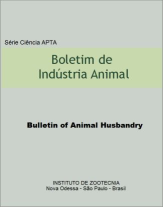Accumulation of marandu forage over the year as a function of cattle feces
DOI:
https://doi.org/10.17523/bia.v73n3p180Keywords:
Brachiaria brizantha, stem, growth, leaf, senescence.Abstract
It is possible that the effects of feces on pasture forage accumulation depend on the climate, which is specific in each season of the year. Therefore, the objective of this study was to evaluate the dynamics of Brachiaria brizantha cv. marandu forage accumulation during the seasons of the year and at sites close to or distant from feces deposited by grazing cattle. A randomized block design with four replicates was used. The following response variables were calculated: leaf growth rate (LGR), stem growth rate (SGR), total growth rate (TGR), leaf senescence rate (LSR), leaf accumulation rate (LAR), total accumulation rate (TAR), and forage utilization. Cattle feces influenced LGR, TGR, LAR and TAR, with higher rates (P<0.05) being observed in plants close to feces (64, 78, 54 and 68 kg DM/ha/day, respectively) compared to those distant from feces (51, 69, 41 and 58 kg DM/ha/day, respectively). Except for LSR which was higher (P<0.05) in winter (20 kg DM/ha/day), all other variables showed higher values in summer. Forage utilization was lower (P<0.05) in winter (11.9%) compared to the other seasons of the year (88.7, 93.6 and 85.1% in spring, summer and autumn, respectively). The deposition of cattle feces on Brachiaria brizantha cv. marandu pasture increases forage growth, irrespective of the season of the year. The climate exerts greater influence on marandu forage accumulation than the presence of cattle feces.Downloads
Downloads
Published
Issue
Section
License
Os autores não serão remunerados pela publicação de trabalhos, pois devem abrir mão de seus direitos autorais em favor deste periódico. Por outro lado, os autores ficam autorizados a publicar seus artigos, simultaneamente, em repositórios da instituição de sua origem, desde que citada a fonte da publicação original seja Boletim de Indústria Animal. A revista se reserva o direito de efetuar, nos originais, alterações de ordem normativa, ortográfica e gramatical, com vistas a manter o padrão culto da língua e a credibilidade do veículo. Respeitará, no entanto, o estilo de escrever dos autores. Alterações, correções ou sugestões de ordem conceitual serão encaminhadas aos autores, quando necessário. Nesses casos, os artigos, depois de adequados, deverão ser submetidos a nova apreciação. As opiniões emitidas pelos autores dos artigos são de sua exclusiva responsabilidade. Todo o conteúdo deste periódico, exceto onde está identificado, está licenciado sob a Licença Creative Commons Attribution (CC-BY-NC). A condição BY implica que os licenciados podem copiar, distribuir, exibir e executar a obra e fazer trabalhos derivados com base em que só se dão o autor ou licenciante os créditos na forma especificada por estes. A cláusula NC significa que os licenciados podem copiar, distribuir, exibir e executar a obra e fazer trabalhos derivados com base apenas para fins não comerciais.













